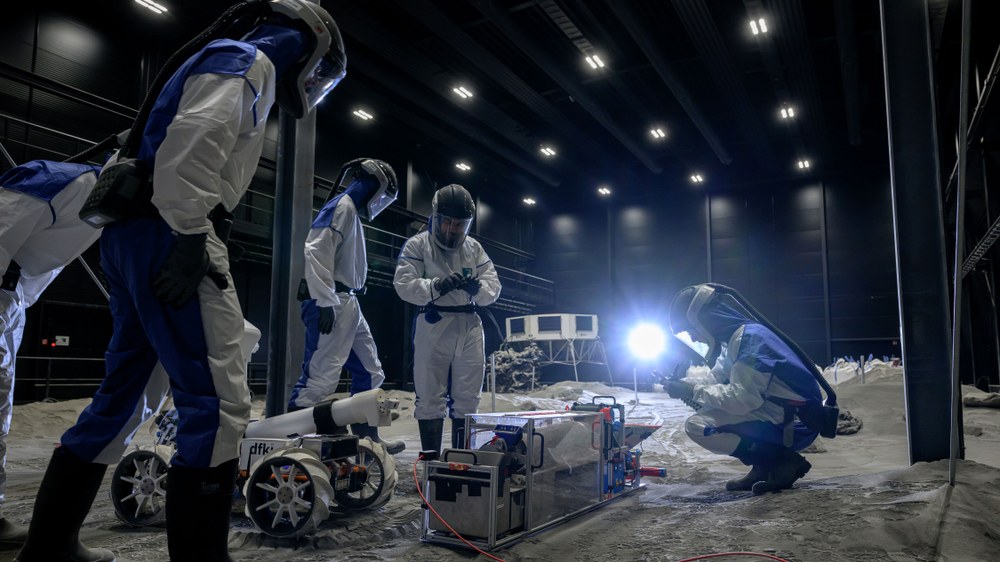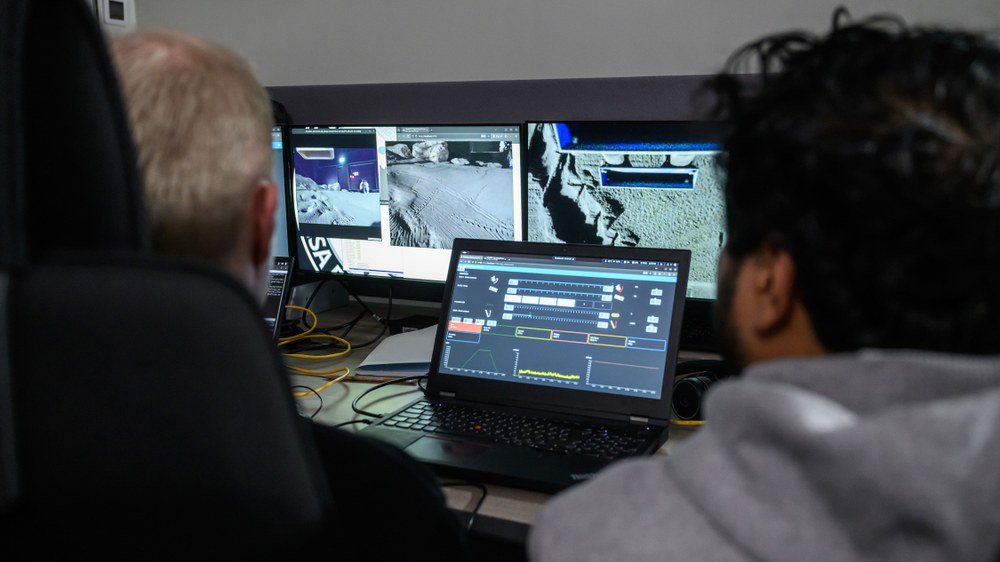Team Bremen competes in the ESA Space Resources Challenge 2025



- The task of the current ESA Space Resources Challenge is to develop technologies for processing lunar dust (regolith).
- Oxygen and building materials, for example, can be extracted directly on the Moon from regolith.
- DLR and DFKI, competing together as Team BREMEN, tested their system in the LUNA hall in Cologne.
- Focus: Space, exploration
From 13 to 17 October, eight teams competed against each other in the ESA Space Resources Challenge 2025 at the LUNA hall in Cologne, Germany, where they tested their innovative space applications. Among them was Team BREMEN (Beneficiation of REgolith and Mobile Excavation). The LUNA Hall provides a realistic environment for preparing future astronautical and robotic Moon missions. The facility is a joint project of the German Aerospace Center (Deutsches Zentrum für Luft- und Raumfahrt; DLR) and the European Space Agency (ESA) at DLR’s site in Cologne.
The goal of this year’s ESA Space Resources Challenge is to develop technologies for processing lunar dust, known in technical terms as regolith. Regolith can be used to extract oxygen and building materials directly on the Moon. The aim is to ensure a sustainable and independent supply for future astronauts.
Mobile rover for extracting resources from lunar dust
The initial scenario: It's the 2040s and humans are permanently stationed on the Moon. Lunar raw materials are mined and used directly on site. To efficiently extract resources such as oxygen or metals, astronauts must first sort regolith particles by size.
For this future scenario, Team BREMEN brings together two strong partners: the DLR Institute of Space Systems, with its expertise in the collection and processing of materials on celestial bodies such as asteroids or the Moon, and the German Research Center for Artificial Intelligence (DFKI), which cooperates closely with the University of Bremen and has globally recognised expertise in space robotics. Together, they have developed a modular system consisting of the mobile rover Coyote III, which collects regolith and transports it to a stationary processing unit, where it is sorted by size and prepared for further use.
"Our goal is to develop technologies that enable a sustainable presence on the Moon. This requires solutions that prove themselves directly on site – and that is exactly what we are testing in this competition. Our system worked very well, and we are very satisfied with the results," says Institute of Space Systems project manager Paul Zabel.
"Robotics is key to reducing the workload of humans in space. With our Coyote III rover, we were able to demonstrate how a mechanically robust, all-terrain and modularly expandable robot can reliably collect and analyse data while moving safely and efficiently across Moon-like terrain," adds Mehmed Yüksel, head of space robotics at DFKI.
Team BREMEN in international competition
In addition to Team BREMEN from Germany, teams from Poland, Canada, Denmark and the United Kingdom are taking part in the competition. Each team contributes its own expertise in robotics, materials science and space technology.
Bremen is known as the 'City of Space' and benefits from its unique research and industrial infrastructure. In addition to DLR and DFKI, numerous companies and universities conducting research in the fields of space, robotics and advanced technology are based in Bremen.
Related links
About the ESA Space Resources Challenge
The ESA Space Resources Challenge is an initiative launched in 2021 by ESA and the European Space Resources Innovation Centre (ESRIC) to foster innovation. The competition aims to encourage the development of innovative solutions for the European space programme, inviting industry and research institutions to compete for a prize. The ESA Space Resources Challenge aims to promote innovation by stimulating international cooperation between science, industry and research organisations for the further development of space resources. The current competition will run until November 2025, when the winning teams will be announced. The overall best team will receive 500,000 euros in prize money from ESA for further research, while the best team in the 'regolith sorting' category will receive up to 250,000 euros from the Luxembourg Space Agency (LSA) and ESRIC.
About LUNA
The LUNA Analog Facility in Cologne is a unique installation for preparing future astronautical and robotic lunar missions. Among other things, the LUNA hall contains a 700 square-metre simulated lunar surface. It is filled with 'Moon dust' that is deceptively similar to real regolith. Stones and rocks are modelled on lunar geology, and a Sun simulator creates light conditions similar to those on the Moon. An area lowered by three metres allows drilling techniques to be tested, and in the future, experiments with an inclined plane will be carried out on an adjustable ramp.
The Gravity Offloading System will soon replicate the Moon's gravity, with trolleys and rope systems to be installed on the ceiling so that astronauts and rovers can move around as if they were on the Moon, as if under one-sixth of Earth's gravity. FLEXhab, a living area for astronauts, has been in place for several months. The EDEN LUNA research greenhouse will be connected as a further external module. LUNA was officially opened on 25 September 2024. The state of North Rhine-Westphalia is funding the DLR-ESA joint project with 25 million euros.
